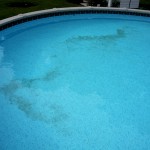The Cure For Common Pool Stains
ByA stain on the wall or floor of a swimming pool is either caused by metals in the pool water, or by something organic. The best clue to the source of the problem is the color of the pool stain. Stains on the walls or floor of a pool that are a greenish brown color are typically related to something organic, such as leaves sitting on the floor of the pool during the winter, or algae. A simple shock treatment and scrubbing with a stiff brush may quickly remove the stain. If brushing or scrubbing does not remove or lighten the stain, a natural ascorbic acid based product or diphosphonic acid based pool stain remover should be used. If a pool stain appears at the water line of the swimming pool you may use the appropriate tile or vinyl cleaner to gently scrub the stain away, or you might try one of the many very effective enzyme based cleaners. All natural pool enzymes will eat away at the oils holding dirt on the surface of the pool at the water line, to remove the stain with little or no scrubbing.
Stains that appear reddish brown or very dark colors are typically related to the metals in your pool water. The metals that commonly cause pool stains are iron, manganese & copper. A guide to the color of pool stain resulting from each of these metals is included below. If a swimmer’s blonde or light colored hair turns green after swimming in your pool, this is an indication that there is a high concentration of copper in the water.
- Copper – Blue, Green or dark (Black)
- Iron – Rusty, Brown or Green/Brownish
- Manganese – Brownish/Black or Purple
These metals can occur naturally, and may be in the water you use to fill the pool. If you have hard water or fill your pool with well water you are more likely to have metal pool stain problems, and regular testing for metals is suggested. Metals may also be introduced into the pool when the pool pH or pool alkalinity levels are not properly maintained, and the water becomes corrosive. Corrosive pool water will eat away at the pool surface and inside of pool plumbing and equipment, releasing metals into the water. The plumbing inside a swimming pool heater, called the “heat exchanger”, is made of copper. If the pool pH and pool Alkalinity levels are not properly maintained, this heat exchanger will quickly corrode and dissolve copper into the pool water causing pool stains.
The first step to eliminating a pool metal stain is to have the pool water tested for metals, and determine how the excess metals were introduced into the water. Take measures to prevent the stain from quickly returning. If there are excessive amounts of metals in your pool water, and stains return again and again after trying each method of treatment, you should partially drain the pool and re-fill with fresh water that has been tested to confirm there is very little or no metals. As with stains caused by something organic, metal pool stains can be easily removed using a natural ascorbic acid based product or diphosphonic acid based product. Another method for removing stains from the floor of a pool is to place ½ pound of pH Reducer in a sock, and drop the sock onto the stain. Position the sock with your telescoping pole, and leave it on the pool stain for 5-10 minutes. If the stain has been removed, place the sock on each affected area for 5-10 minutes.
Article Source: http://EzineArticles.com/116782















